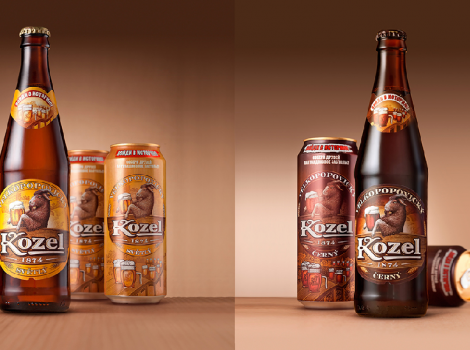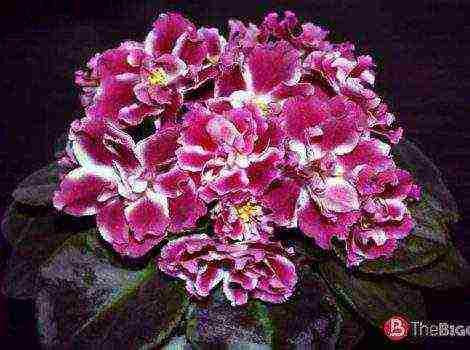Content [show]
Sometimes beginners confuse the name of this variety and call it Debarau, but such a variety is not registered anywhere and therefore does not exist yet. Now we will talk about the wonderful De Barao tomato variety without flaws, the characteristics and description of which are presented below.
Characteristics of the tomato variety De Barao
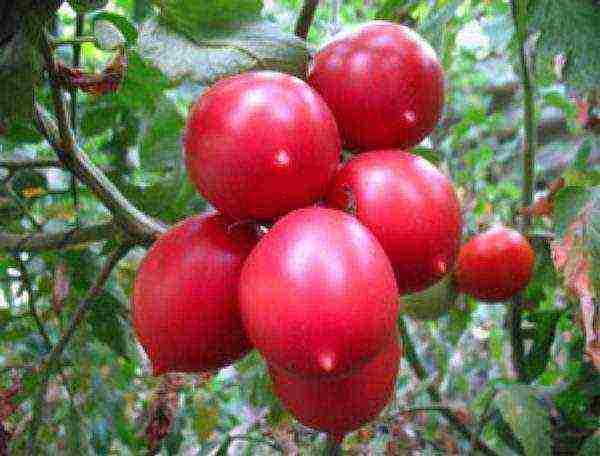 Tomato variety De Barao
Tomato variety De Barao
This variety conquered gardeners in the 90s, and many are still planted. It has many subspecies of fruits, different in color and shape. The bush is indeterminate, powerful. We can say that bushes of this variety give rich yields consistently regardless of weather conditions... Tomatoes are suitable for eating in salads and preservation. Seedlings are easy to grow and you can get up to 20 kg from one bush. tomatoes.
It is necessary to approach the cultivation of this variety correctly in order to get a great return on the harvest.
Description of the variety
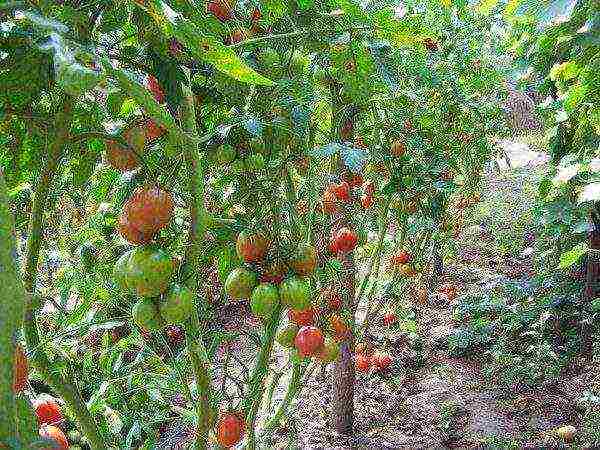 Tomato De Barao is a tall tomato variety with high yields and disease resistance
Tomato De Barao is a tall tomato variety with high yields and disease resistance
The trunk is strong, not fragile, on which there are many dark green tomato-type leaf plates. Up to 10 pieces are tied on a bush. brushes, each of which has 7 fruits equalized by weight... Late ripening variety. The variety can be cultivated both in the greenhouse and in the open field.
Fruiting continues until frost.
| Bush | Height 4 m. |
| Ripening period | 110-120 days. |
| Yield | 20 kg. from one bush. |
| Fruit shape | Depending on the species, but mostly oblong. |
| Tomato color | Depends on the type - pink, red, yellow, etc. |
| Average berry weight | 90-130 gr. |
| Skin | Medium firmness. |
| Pulp | Juicy and tender. |
| Transportation | Excellent. |
| Storage | Up to two months after removal from the bush. |
Advantages and disadvantages
 De Barao fell in love with gardeners not because of his size, but because of his high yield
De Barao fell in love with gardeners not because of his size, but because of his high yield
This variety simply does not have any flaws, the tomato has only positive qualities:
- Not picky about care;
- Can be grown in partial shade;
- Frost resistant;
- Possesses high productivity;
- Possesses good resistance to tomato-type diseases;
- Has a long shelf life.
Possessing such positive qualities, a tomato of this variety should be in the personal plot of a skilled gardener.
Types - how do they differ
De Barao is the general name of the variety, but our breeders have bred many types of these tomatoes, which differ in:
- Fruit shape;
- Fruit color;
- Food and gustatory qualities.
Pink
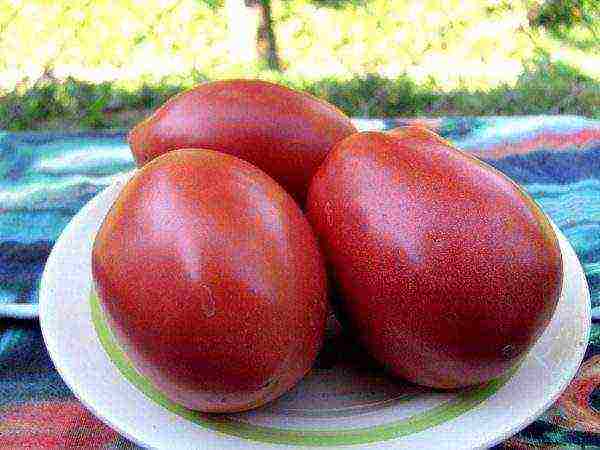 Pink De Barao
Pink De Barao
For full maturation, the species needs 115 days from the first shoots. When fully ripe, tomatoes have a pink color and a beautiful presentation.... Positive qualities - frost resistance, shade tolerance, amicable yield of the crop, resistance to diseases.
Black
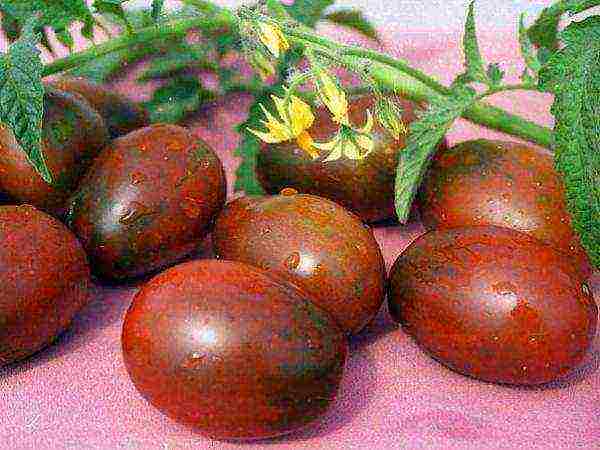 Black De Barao
Black De Barao
This subspecies differs from others only in the color of the fruits. They are dark purple-red and weigh 50 grams. The fruits of the Black Giant ripen on 115 days. All positive qualities are the same as in other subspecies.
Red
The subspecies of the variety gives a consistently large yield up to 6 kg from a bush when grown properly. The fruits weigh an average of 110 grams.
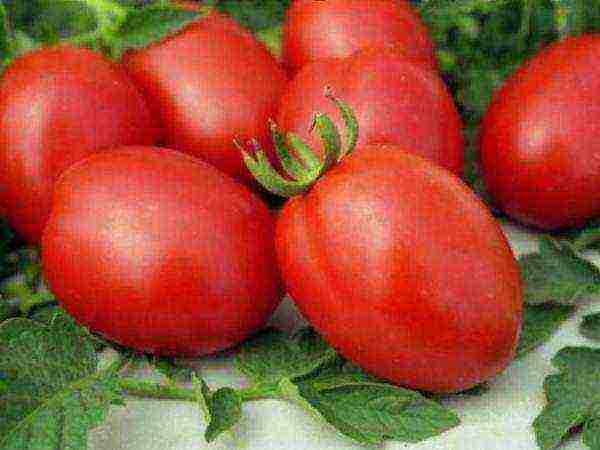 Red De Barao
Red De Barao
Positive traits:
- Shades well;
- Doesn't get sick;
- Tolerates a drop in temperature;
- It has a good harvest of marketable fruit.
Negative qualities:
- Bushes are powerful requiring pinching and removal of excess leaf mass.
An excellent subspecies for conservation. it will look especially beautiful in a jar if you mix two types in one container - gold and red De Barao.
Tsarsky
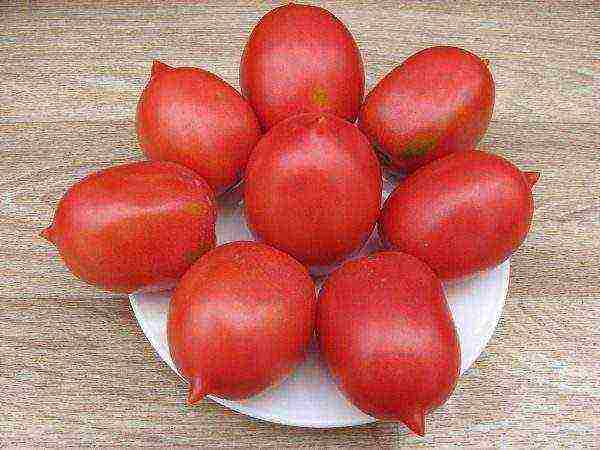 Tomato De Barao Royal
Tomato De Barao Royal
This is De Barao's crop species, as on average, 15-20 kg are harvested from a bush in open ground conditions.
Positive traits:
- Duration and the abundance of the return of the crop;
- Sustainability to diseases;
- Long shelf life plucked fruits;
- Universal application of tomatoes;
- Postpones downgrade temperature.
Negative qualities:
- Strong growth requires high and solid support;
- Need pinching.
The Tsarsky variety will not leave the gardener without a harvest of excellent commercial tomatoes, which have a wide range of uses from salad use to conservation.
Giant
 Tomato De Barao Giant
Tomato De Barao Giant
The bush will grow more than 2 m mark, the average weight of tomatoes of this variety is 150 g, the color of the tomatoes is red and plum-shaped.
The yield is 6 kg per bush.
Gold
Tomatoes have a wonderful taste and have a golden color in their fruits. Ripening period is 115 days.
 De Barao Gold
De Barao Gold
Positive traits:
- Partial well tolerated growth in the shade;
- Stably big harvest;
- Disease resistance and temperature drops.
Negative qualities:
- Large bushes;
- A lot of leaf massthat you have to partially remove.
Orange
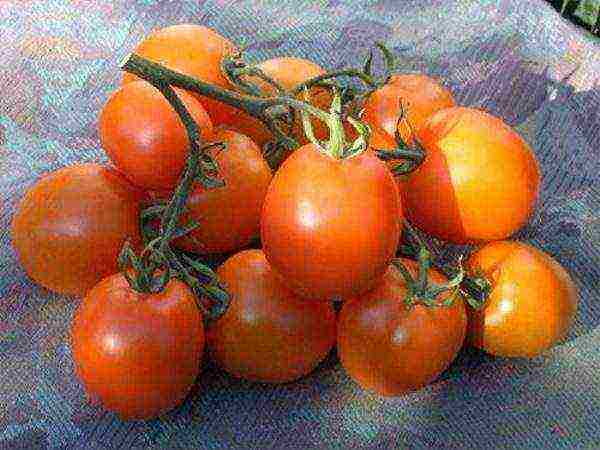 De Barao Orange
De Barao Orange
The ripening period is 125 days on average. The fruits are lined in orange color. The yield is 12 kg per bush... Fruits until the very frost and has the same positive qualities that are inherent in various types of De Barao.
The order of growing tomatoes in a greenhouse
This is a wonderful kind of tomato, which in greenhouse conditions can give the maximum yield of beautiful tomatoes.
The greenhouse for these tomatoes should be at least 3 m high, since tomato vines can reach 4 m in length.
Preparation of material for planting
Seeds should be prepared for planting. First of all, they are checked for germination. To do this, dilute a teaspoon of salt in a glass of water and stir it thoroughly in water. Seeds are dipped into this saline solution and those that have surfaced are not suitable for further germination.since there is no life in them. The rest of the seeds must be disinfected and for this they are dipped in a pink solution of potassium manganese for half an hour. Only after these procedures begin planting seeds.
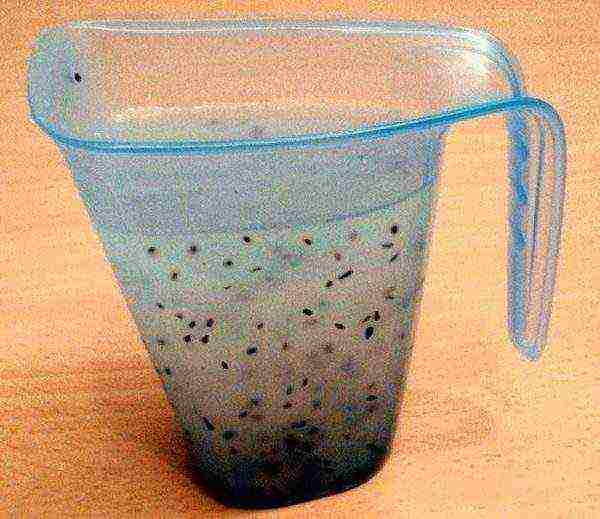 Checking tomato seeds for germination
Checking tomato seeds for germination
It is necessary to go through these stages so that you do not needlessly wait for the emergence of a sprout from an empty seed.
When to plant
For sowing in a greenhouse, seeds are sown in prepared containers at the end of February. To get good seedlings at the exit, you should adhere to certain rules:
- The container should be about 12 cm high and have drainage holes to drain off excess water after irrigation.
- Soil for growing seedlings should be nutritious and loose. It can be purchased in a specialized store, or you can make it yourself, taking everything in equal shares - peat, garden soil, earth from a compost heap.
- Seeds are planted to a depth of 1.5-2 cm, then cover with glass and wait for shoots for 3-6 days.
- When most of the seedlings are already above the soil surface, glass is removed and seedlings are grownwatering and turning it on different sides in relation to the sun.
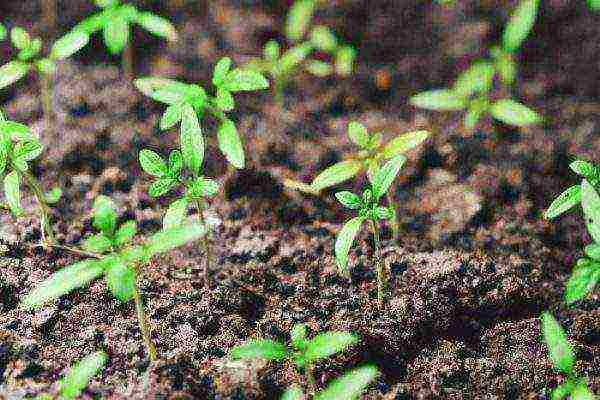 Tomato seed shoots
Tomato seed shoots
- Dive seedlings I do it when there are two true leaves on the sprouts and transfer them to 500 gr. cups.
Take cups of exactly this size, since a tall bush and seedlings are appropriate.
Basic care requirements
Watering
This is a prerequisite for tomato cultivation. They are made weekly and with warm water.to avoid decay of the root mass. It is better to water in the evening so that the plant has time to be saturated with water during the night.
After watering, be sure to loosen the soil in order to increase the access of oxygen to the root system.
Top dressing
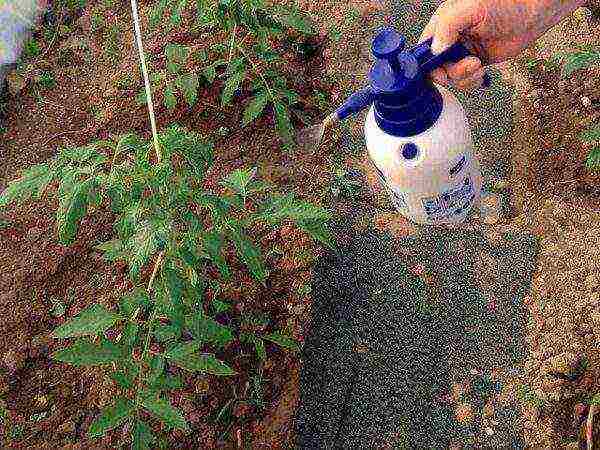 Top dressing of tomato bushes when grown in greenhouses is carried out in two stages
Top dressing of tomato bushes when grown in greenhouses is carried out in two stages
First feeding the bush is provided 10 days after planting the seedlings - they are fed with nitrogen fertilizers. The second bring in during the formation of buds, it should be a phosphorus-potassium supplement and preferably in a liquid state. You should not overfeed tomatoes, as this will adversely affect the quality of the tomatoes.
Top dressing should be applied only on damp ground, so as not to burn the plant root system.
When and how to harvest
De Barao fruits begin to ripen 4 months after the seedlings emerge. Fruiting is long and stops only when the temperature drops to minus... Tomatoes can be picked at a young age, and they will reach normal ripeness when ripe.
Outdoor cultivation
Growing in open ground is not much different from growing in a greenhouse, the only thing is that the yield will be smaller, since its amount will depend on weather conditions. Seedlings will be planted in the ground later and the crop will be frosty earlier than in the greenhouse.
Preparation of material for planting
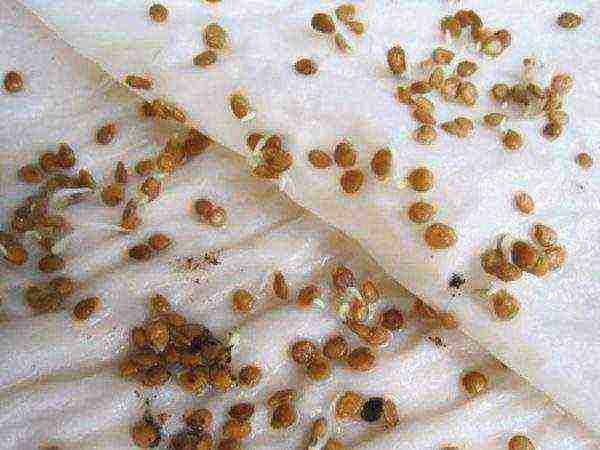 Soaking tomato seeds before planting
Soaking tomato seeds before planting
Seeds are prepared according to the same principle as for planting seedlings for greenhouse conditions.
When to plant
Planting time is shifted by a month. In the southern regions of Russia, the planting of seeds for seedlings begins in mid-March, The Moscow region and all regions located at its latitude sow seeds in the last days of March.
It is necessary to adhere to the timing, since the elongated one takes root in the open field not as easily as the seedlings of normal growth.
Basic care requirements
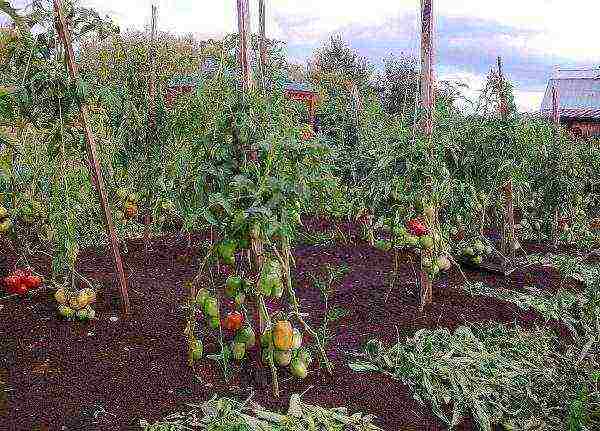 De Barao tomato bushes on a support
De Barao tomato bushes on a support
The care requirements are absolutely no different from the care in the greenhouse. The same watering and feeding. Loosening and removal of weeds is carried out on the second day after watering... The only thing that the necessary support for the bushes is stuck in at the stage of planting seedlings. This is done to avoid damaging the roots.
Stakes driven into the ground must be at least 3.5 m in height.
When and how to harvest
The harvest begins in late July and early August. It all depends on the weather conditions and the presence of cold nights. The more there are, the less the tomato ripens..
The wonderful variety of tomatoes of this variety will always delight the gardener with its result. Even a beginner will not be left without a crop, the main thing is to adhere to the recommendations for growing this variety.
Tomato is a vegetable that came to us from South America. Wild relatives of agriculture are still growing on the continent. The plant belongs to the Solanaceae family and is considered, oddly enough, a berry. In culinary and commercial terms, tomatoes are classified as vegetables.

The history of the appearance of tomato in Europe and Russia
In Europe, the plant appeared towards the end of the 16th century. The inhabitants of the Old World were in no hurry to use the fruits of an unfamiliar culture for food, as they considered them poisonous. Neapolitan chefs first included the tomato recipe in a cookbook in 1692. It appeared in Russia only in the eighteenth century.
Why did the tomato become a tomato?
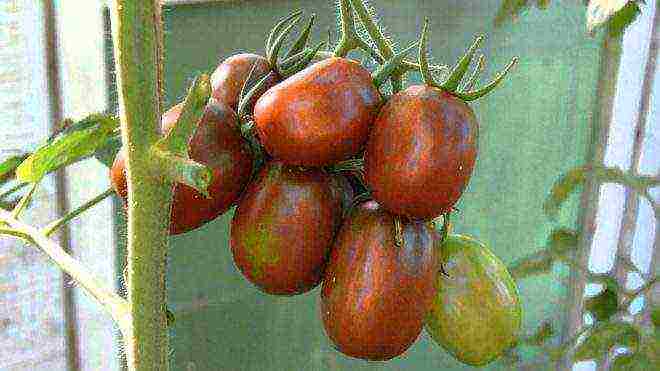 The name "tomato" is translated from Italian as "golden apple". This shows how highly the expressive nation appreciated the taste and aroma of tomatoes.For Italians, a tomato is comparable to real gold, because a traditional pizza or pasta is hard to imagine without a South American vegetable. Many other recipes of this country are also not complete without red, juicy and aromatic fruits. Also see the article on planting tomatoes for seedlings.
The name "tomato" is translated from Italian as "golden apple". This shows how highly the expressive nation appreciated the taste and aroma of tomatoes.For Italians, a tomato is comparable to real gold, because a traditional pizza or pasta is hard to imagine without a South American vegetable. Many other recipes of this country are also not complete without red, juicy and aromatic fruits. Also see the article on planting tomatoes for seedlings.
De Barao is a tall "breadwinner"
One of the most productive and unpretentious to care for is the De Barao variety, represented by a wide variety of varieties. The late-ripening, tall variety of De Barao tomatoes gives a stable and rich harvest, so it can become a real breadwinner for the family.
Description of the variety
Scientists have worked on the variety beloved by many gardeners and brought out a wide variety of representatives of the De Barao variety: Pink, Tsarsky, Black, Orange, Red, Giant, Gold, Tiger, Yellow.
As a rule, De Barao tomato characteristic and description of the variety include the following parameters:
- Indeterminate type of growth. The top constantly throws out inflorescences, which are tied into fruits.
- Tall plant - 2-3 meters in height. Such giants require a garter.
- Productivity and long fruiting period. The plant constantly blooms and bears fruit continuously. Fertility - 4-15 kilograms from one bush per season.
- Average ripening times. After the first leaves of seedlings appear, the plant will need 115-120 days to produce the first harvest.
- Possibility of growing in unprotected soil and "covered garden". The first option is suitable for the southern parts of Russia, the second - for the middle zone and northern regions.
- Fruits are elongated, weighing 50-70 grams. Depending on the variety, they come in different colors: yellow, red, black, pink. The pulp content is increased. Taste qualities are excellent: juicy, sweet and sour fruit with a delicate aroma.
- The variety tolerates shade well, which is an important advantage in plant cultivation.
- All varieties of the variety are unpretentious plants that produce a bountiful harvest.
- Good disease resistance.
Thanks to the qualities listed above, the variety is popular among gardeners, as evidenced by reviews of De Barao tomato on garden sites.
Royal Tomato
The characterization and description of the De Barao Tsarsky tomato should begin with the extraordinary yield of the variety. Average fertility rates are 10-15 kilograms per bush. If you provide the plant with proper care, you can achieve even higher rates - 20 kilograms per plant.
Advantages and disadvantages of tomato varieties De Barao Tsarsky
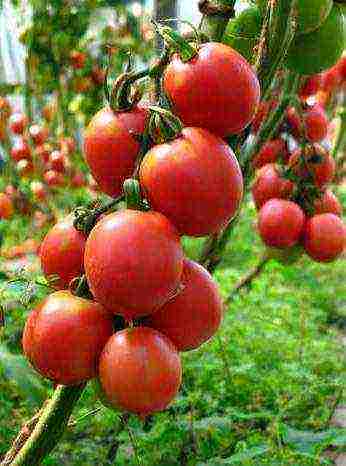 Usually, reviews about De Barao Tsarsky tomato contain information about its positive and negative qualities.
Usually, reviews about De Barao Tsarsky tomato contain information about its positive and negative qualities.
The advantages of the variety include long-term and abundant fruiting, disease resistance, good "keeping quality" of fruits, as well as a variety of use of vegetables (fresh, frozen, pickled and salted versions). An equally useful property of the plant is the fact that it tolerates significant drops in temperature well.
The disadvantage that the tomato of De Barao Tsarsky has is considered to be its "tall growth", since it requires a powerful support. Without a strong, stable trellis, yields are reduced many times. In addition, due to the large size of the plant, farmers have to allocate a large plot of land for one De Barao Tsarsky bush. Another disadvantage is the need for pinning.
Fruits of the De Barao Tsarsky variety
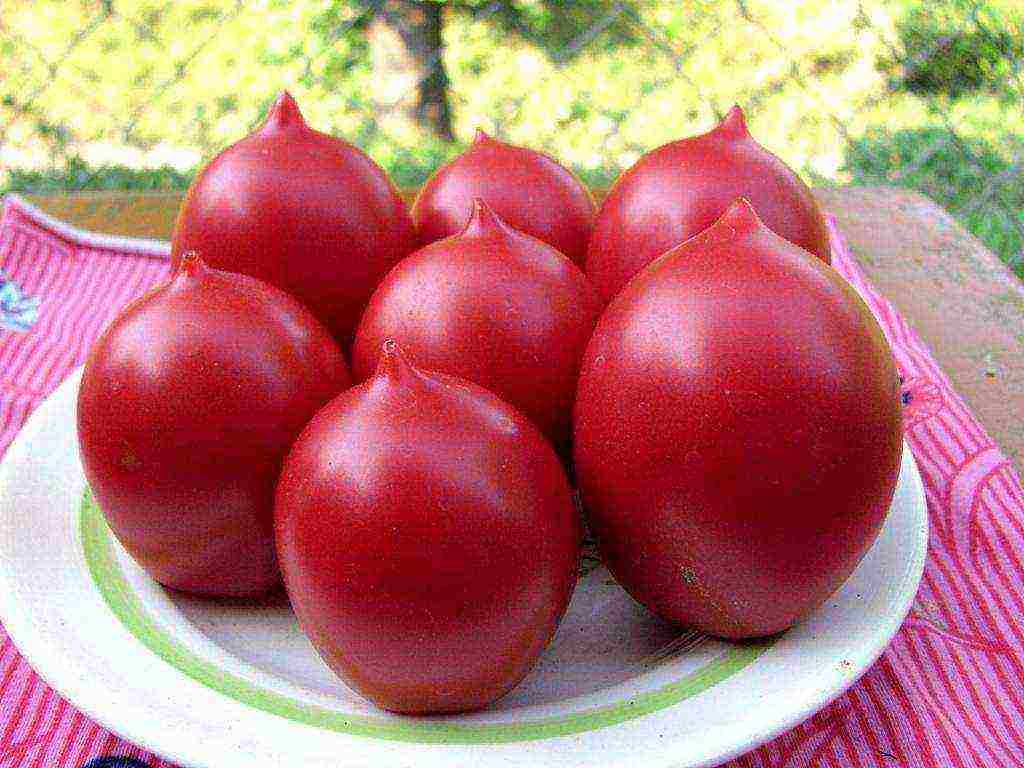 The quality of the harvest of the De Barao variety is high. Fruits are glossy, oblong, medium-sized, reddish-pink in color, of high palatability. The weight of one "berry" averages 150-160 grams. The "royal" variety is the largest-fruited representative of the De Barao variety. Most likely, the variety got its name precisely because of the large tomatoes.
The quality of the harvest of the De Barao variety is high. Fruits are glossy, oblong, medium-sized, reddish-pink in color, of high palatability. The weight of one "berry" averages 150-160 grams. The "royal" variety is the largest-fruited representative of the De Barao variety. Most likely, the variety got its name precisely because of the large tomatoes.
If the fruits are plucked green, they will ripen for a long time at home, gradually forming a "apartment tomato crop".Since the fruits of the variety are fleshy, they make a wonderful, thick tomato paste, as well as sun-dried tomatoes.
In general, the fruits of the De Barao Tsarsky variety can be used for any culinary purposes, this is their versatility.
Tomato gold
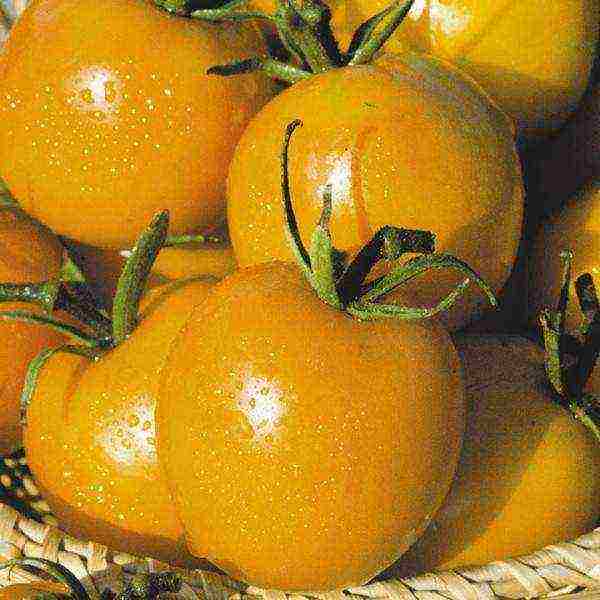 De Barao Golden tomatoes justify the Italian name “golden apple” not only due to their excellent taste, but also to the yellow color of the fruit. This variety has another name - De Barao Yellow. The variety is average in terms of ripening, the growing season lasts 110-120 days.
De Barao Golden tomatoes justify the Italian name “golden apple” not only due to their excellent taste, but also to the yellow color of the fruit. This variety has another name - De Barao Yellow. The variety is average in terms of ripening, the growing season lasts 110-120 days.
Often reviews about the De Barao Yellow tomato contain only positive comments: high yield, good shade tolerance, resistance to cool temperatures and diseases, beautiful, fleshy and "lying" fruits that can be left to ripen. The fruits are oval, bright yellow. The average weight of one tomato is 60-90 grams.
However, reviews of the De Barao Golden tomato also mention some small disadvantages: the large size of the bushes and the need to remove excess green mass.
Red De Barao
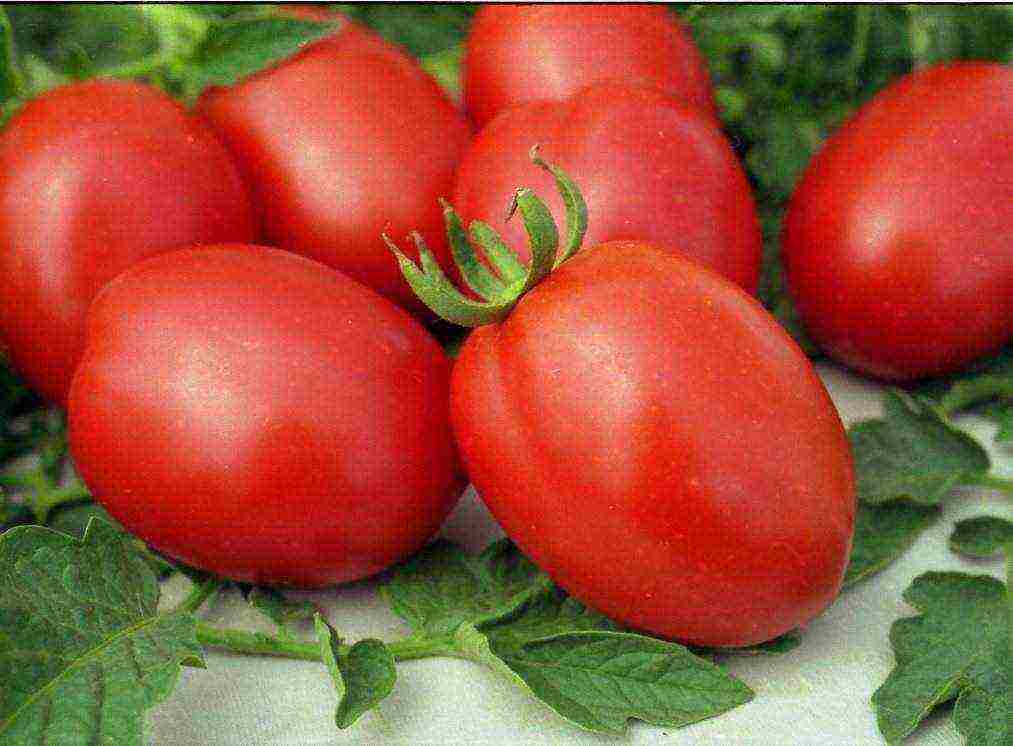 In many ways, the description of the tomato De Barao Red coincides with its "close relative" De Barao Golden. It also produces a large crop - up to six kilograms per bush, tolerates shade and cold air. The variety is practically resistant to pests and diseases.
In many ways, the description of the tomato De Barao Red coincides with its "close relative" De Barao Golden. It also produces a large crop - up to six kilograms per bush, tolerates shade and cold air. The variety is practically resistant to pests and diseases.
The only difference is the color of the fruit. Here the name speaks for itself. Beautiful, bright red vegetables, weighing 90-120 grams each, resemble an oval in shape and are often called "cream".
Just like other De Barao varieties, the red-fruited plant is a very tall and powerful shrub. For him, you will have to allocate a fairly large part of the land for greenhouses. And the greenhouse should be large to accommodate a two-meter giant. In order for all the power of the plant to go to the formation of fruits, the bushes need to be pinned, removing excess foliage.
Black De Barao
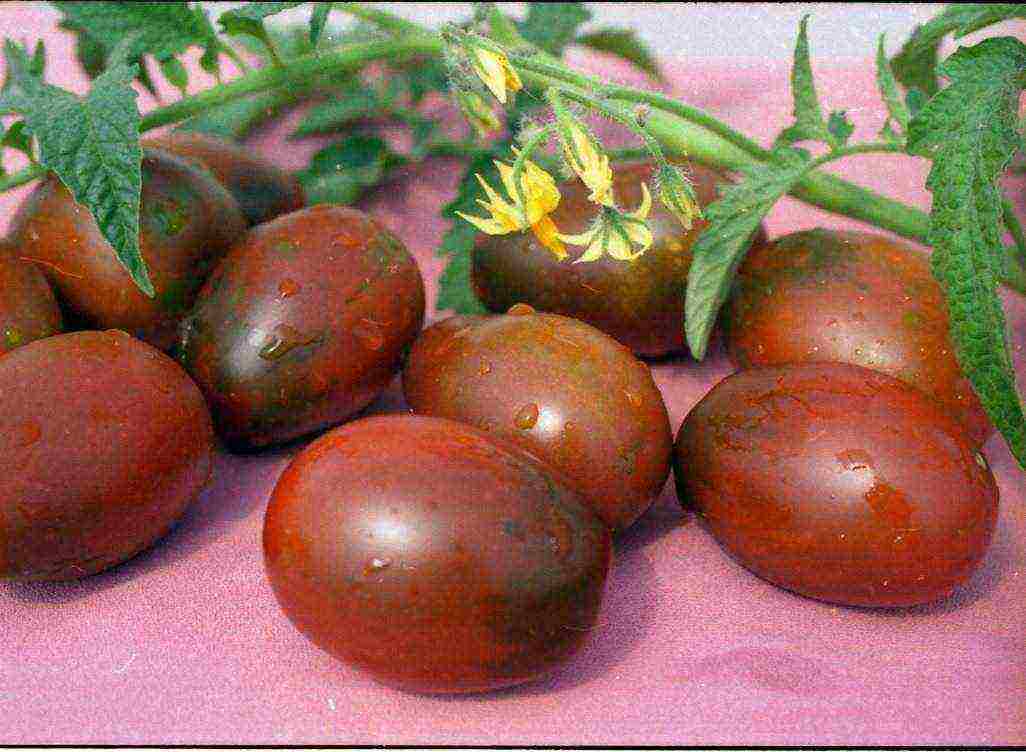 All of the above advantages and disadvantages are possessed by the De Barao Black tomato with an unusual appearance of the fruit. Yielding, frost-resistant, disease-resistant, shade-tolerant, not difficult in agricultural technology - all these are the characteristics of the De Barao Black variety. But for all the similarity of the parameters, its fruits cannot be confused with anything. The dark, purple-red oval-shaped vegetables weigh 40-70 grams each and taste good. The variety is medium late, the growing season lasts 115-130 days. De Barao Black is a very tall variety, plant height reaches 2.5-3 meters. Best grown in tall greenhouses. Read the article: Black tomatoes: the best varieties, their brief quality characteristics.
All of the above advantages and disadvantages are possessed by the De Barao Black tomato with an unusual appearance of the fruit. Yielding, frost-resistant, disease-resistant, shade-tolerant, not difficult in agricultural technology - all these are the characteristics of the De Barao Black variety. But for all the similarity of the parameters, its fruits cannot be confused with anything. The dark, purple-red oval-shaped vegetables weigh 40-70 grams each and taste good. The variety is medium late, the growing season lasts 115-130 days. De Barao Black is a very tall variety, plant height reaches 2.5-3 meters. Best grown in tall greenhouses. Read the article: Black tomatoes: the best varieties, their brief quality characteristics.
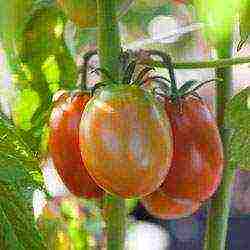 A tall bush with an abundant number of large fruits - such a characteristic from summer residents was received by the De Barao tomato variety. These tomatoes are able to surprise with the harvest, if you follow the technology and know some secrets of growing. What is remarkable about the description and composition of De Barao tomatoes, what are the features of planting and caring for them - the article will tell you with the help of photos and videos.
A tall bush with an abundant number of large fruits - such a characteristic from summer residents was received by the De Barao tomato variety. These tomatoes are able to surprise with the harvest, if you follow the technology and know some secrets of growing. What is remarkable about the description and composition of De Barao tomatoes, what are the features of planting and caring for them - the article will tell you with the help of photos and videos.
Description of the De Barao variety
De Barao's red tomato originated in Brazil. He "came" to domestic vegetable gardens a little more than 20 years ago. The first harvests were often rather meager, but gradually our gardeners-gardeners got used to getting what they needed: a lot of large and tasty tomatoes. A presentable appearance and sufficient elasticity for transportation makes De Barao an excellent product to sell.
Today, on the plots, you can find several subspecies of this variety: Red, Black, Giant, Golden, Tsarsky, etc. They all have a number of common characteristics:
- can be grown both in the greenhouse and in the garden;
- fruits - medium-sized;
- the average weight of a tomato is 90-120 g;
- the taste is juicy and pleasant (especially in the Tsarsky subspecies);
- stem - powerful, high (up to 300 cm), capable of producing several brushes, each of which forms up to 8-9 tomatoes;
- variety - medium late, growing season - about 4 months;
- mass fruiting - from 115 days after sowing the seeds.
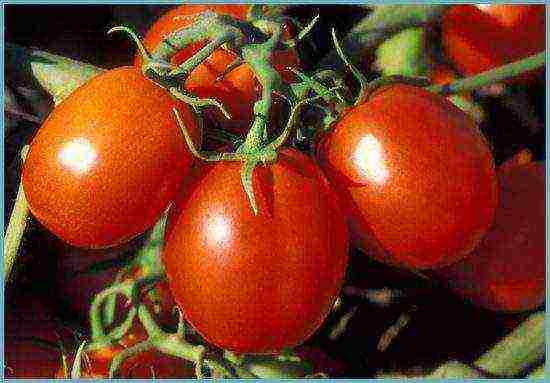
De Barao high yielding variety
Advantages and disadvantages of the variety
De Barao fell in love with gardeners not because of its size, but because of its high yield. Even despite the considerable number of difficulties in care, the variety is very beneficial:
- fruiting does not depend on the abundance of the sun - the bush develops successfully in the most shaded corners of the garden plot;
- tomato does not stop growing after tying a certain number of brushes;
- bears fruit until the first frost;
- not susceptible to late blight;
- universal on the table - salad, tomato paste, as well as canning, including the whole;
- it is stored for a long time and is well preserved during transportation;
- can ripen during storage;
- has an attractive appearance.
At the same time, De Barao requires increased attention. Gardeners call its main disadvantage the bad effect of being adjacent to tomatoes of other varieties. The duration of the growing season led to a fairly early date for planting the tomato - 1-2 weeks earlier than most other tomatoes. For the normal development of the plant, it is necessary to carry out pinching, removing unnecessary brushes for the sake of a better harvest.
The high height of the bush makes it mandatory for additional fastening - with a support or a garter. Otherwise, the branches will break off. Also, tomatoes of this variety need regular and abundant watering. Best of all - warm water in the evening.
Attention! De Barao grows well in lowlands, where dew usually falls in the morning.
Features of the varieties of De Barao
In general terms, each of the types of this tomato has its own characteristics:
- Red is a pioneer, it was he who was brought out at one time in Brazil. It has a relatively low weight and yield compared to its counterparts. Indeterminate variety.
- Orange - contains an increased amount of carotene, which explains its color.
- Pink is less productive than other varieties, but it is very tasty and has a pleasant color.
- Black is a rare tomato variety with a dark color and high density.
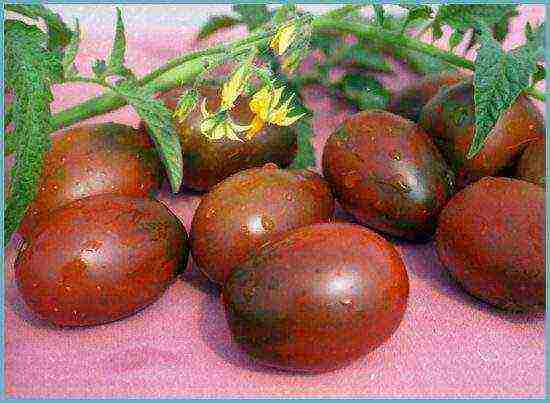
Tomato De Barao black
- Gold is the most productive (up to 7 kg per bush). Tomatoes are also rich in carotene.
- The giant is the largest of the De Barao "family". Weight reaches 210 g. It blooms until autumn and continues to bear fruit in warm weather.
- Tsarsky is a rare variety, the seeds of which cannot be found on the market just like that. Pink-crimson fruits. The best option in terms of taste and overall qualities, therefore, along with the red species, it is in demand by gardeners.
Advice. Tsar's De Barao is just the kind of tomato that bears fruit in late autumn. Green fruits plucked before frost ripen in a warm room.
Features of growing varieties
As a rule, the bush of De Barao tomatoes is formed from two stems. Less often - from one. The favorable climate for this variety is the south, with strict adherence to the watering regime. In the southern regions, tomatoes are grown in the open field, in the middle lane - in greenhouses. It is difficult to grow De Barao in cooler climates because it ripens late. The bush will grow and develop, but the tomatoes will not have time to ripen: the season may end.
Attention! In the second week of life in the ground, the bush begins to grow rapidly. It is important not to miss this moment and provide the plant with the necessary supply of fertilizer, otherwise it will not have the strength to "jerk".
In the process of sowing and caring for the plant, pay attention to the following features:
- sowing of seed is done in March;
- it is necessary to strictly observe the light mode, if necessary - turn on the lamp;
- dive seedlings into pots when a pair of true leaves appears;
- the soil is sprinkled with wood ash;
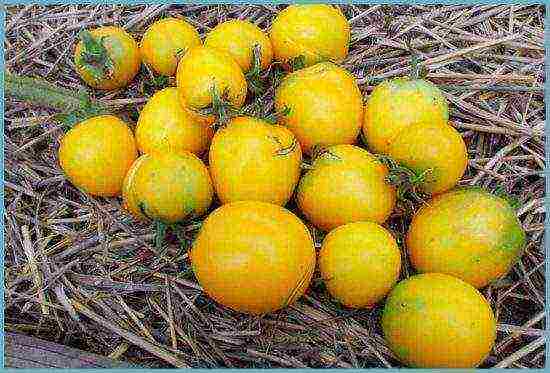
De Barao gold
- before planting, the plants are hardened with fresh air;
- rooting of seedlings usually occurs in mid-May (under the film) or at the beginning of June (in the garden);
- ready-made seedlings for soil - at least 2 months old. and having at least 5 true leaves;
- an approximate layout of seedlings in the ground - 50x55 cm;
- support is required from the first days of life in the garden;
- watering is done exclusively at the root;
- pinching is required.
According to the reviews of people growing De Barao tomatoes, this variety is not the easiest one to cultivate. It is more suitable for experienced summer residents or gardeners. Careful care and attention will result in sweet and juicy fruits on the dining table or in a glass jar, canned.
Review of tomato varieties: video
Tomatoes De Barao: photo
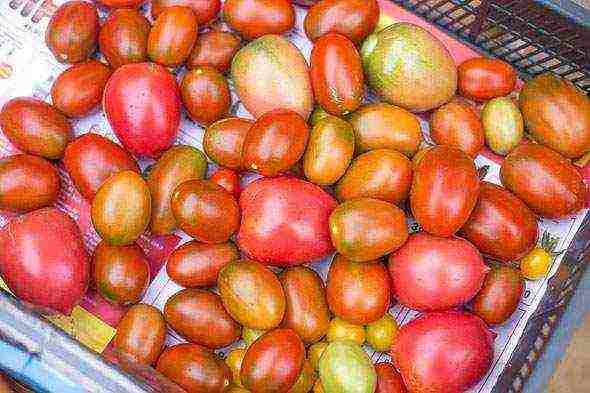
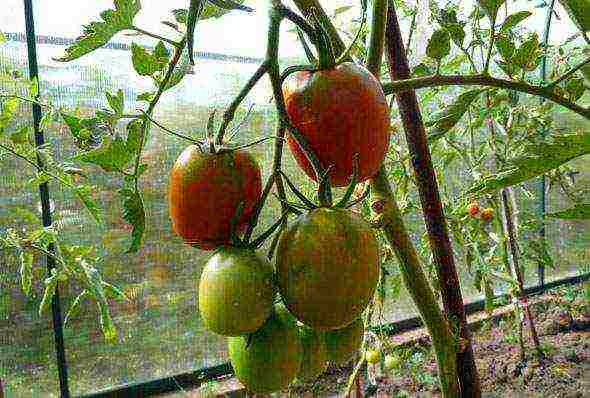
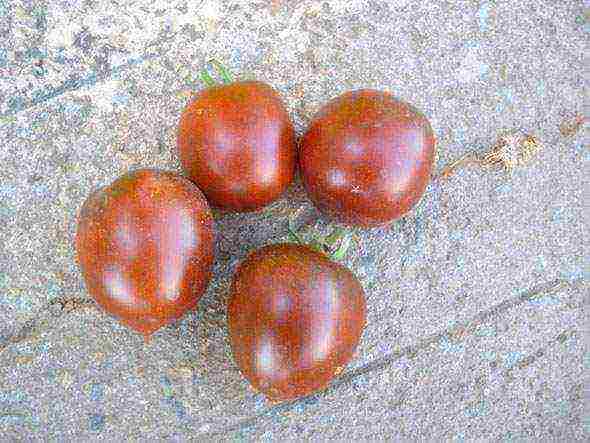
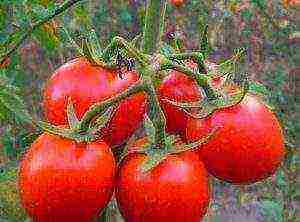
In the spring, there is a lot of trouble on the site, you need to put the beds in order, prepare the tools and choose seedlings for planting this season. For greenhouse owners, I would like to tell you about a special variety of tomatoes.
This is a guest in our country, it is called "De Barao Red"... Its fruits will delight you with their beauty and excellent taste. Our story is about him.
…
Breeding history
"De Barao Red" was bred in Brazil. In Russia, he gained fame since the 90s. Received state registration as a greenhouse variety in 1998. Since then, it has earned popularity among amateur gardeners and farmers growing tomatoes for sale.
Tomato "De Barao Red": variety description and photo
"De Barao Red" is a medium late, very tall, up to 2-3 meters variety of tomatoes, from planting seedlings to ripening of the first fruits, it is like 120-130 daysth. The bush is indeterminate, not standard. Resistant to most diseases.
Due to its very high growth, it is still better to grow it in tall greenhouses, since in the open field there is a possibility of damage to the plant by gusts of wind.
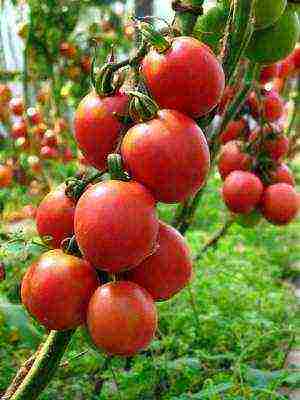 De Barao Red is known for its good yields. With proper care with one plant is usually harvested up to 6 kg, but most often it is 4-5. With a planting scheme of 3 bushes per sq. m, about 15 kg comes out, which is a fairly good indicator.
De Barao Red is known for its good yields. With proper care with one plant is usually harvested up to 6 kg, but most often it is 4-5. With a planting scheme of 3 bushes per sq. m, about 15 kg comes out, which is a fairly good indicator.
Advantages and disadvantages
The main advantages of these tomatoes include:
- beautiful appearance;
- shade tolerance of the plant;
- resistance to temperature extremes;
- resistance to diseases and pests;
- good yield.
Among the disadvantages are:
- in open ground in areas with cold summers it ripens only in a greenhouse;
- does not go well with other varieties of tomatoes;
- requires careful pruning of branches;
- suitable only for tall greenhouses.
Fruit characteristics
Ripe fruits are bright red in color, elongated in shape, in the form of cream. Tomatoes of medium and small size 80-120 gr. The number of chambers is 2-3, the dry matter content is about 5-6%. The harvested fruits can be stored for a long time and tolerate transportation well.
These tomatoes have excellent taste and are very good fresh. De Barao Red fruits are perfect for canning and pickling. Juices and pastes from these tomatoes are rarely made.
Other table varieties of tomato presented on our website:
LapwingsFat boatswainGoldfishDomes of RussiaPride of SiberiaOgorodnikAlfaBendrik's creamRaspberry miracleHeavyweight of SiberiaMonomakh hatGigaloGolden domesGrandmanHoney candy
.
Photos of De Barao red tomato: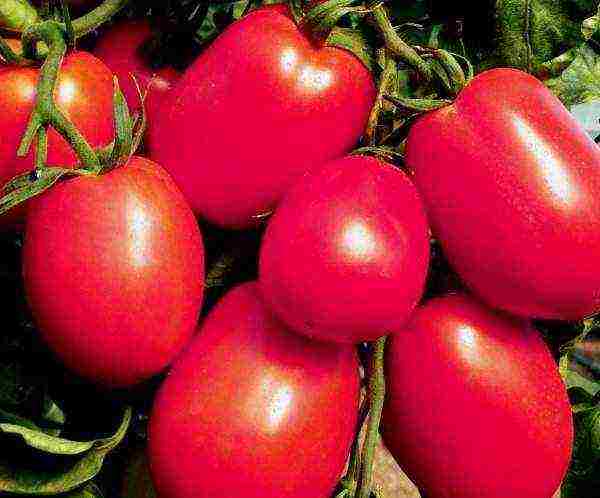
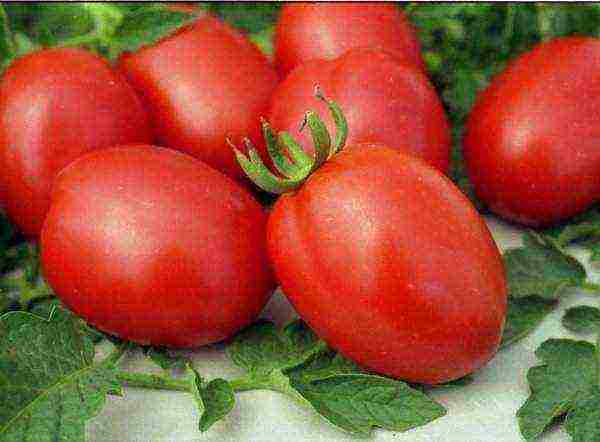

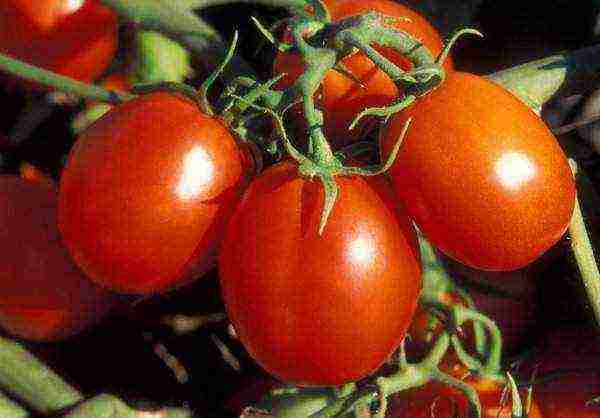
Growing features
For cultivation in open ground, this variety is suitable for the southern regions, such as the Astrakhan region, Krasnodar Territory or Crimea, in cooler places it will not have time to ripen, as it is a late variety. In areas of the middle lane, it is grown in greenhouse shelters.
Important: Due to their very high growth, the bushes of "De Barao Red" must be tied up, and props must be made under its branches, otherwise they may break off.
The bush is usually formed into 2 stems, but it happens that in one, this issue must be approached especially carefully.
Tomatoes of this variety respond very well to complex feeding.
The features include the high growth of the bush, it can reach 300 cm. Also among the features can be noted the resistance of this species to diseases, but the main feature is that it poorly tolerates neighborhood with other types of tomatoes... This feature is often considered to be its main drawback.
Diseases and pests
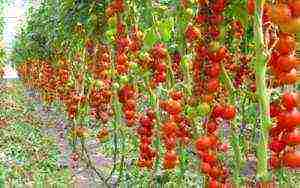 This type of tomato has very good disease resistance, but can still be black bacterial spot.
This type of tomato has very good disease resistance, but can still be black bacterial spot.
To get rid of this disease, the drug "Fitolavin" is used. Top rot of the fruit may also be affected. With this disease, the plant is sprayed with a solution of calcium nitrate and watering is reduced.
Of the most likely pests of this giant, the Colorado potato beetle and slugs are affected.
The Colorado potato beetle is fought by picking it by hand, then the plant is treated with Prestige. Slugs can be fought with a special solution that you can make yourself. To do this, you need to take a spoonful of hot pepper or dry mustard in 10 liters of water, water the soil around the plant with this solution.
Conclusion
This is a rather difficult variety to care for, so it is more suitable for experienced gardeners. But do not worry, you can ask more experienced neighbors for advice, they will help you cope with the problem. Good luck and rich harvests!
Other tomato varieties recommended for greenhouses presented on our website:
ChocolateQishmishYellow pearDomes of RussiaPride of SiberiaPink ImpressionNewbieWonder of the WorldPresident 2De Barao GiantMeaty handsome
.
Video
The proposed video describes in detail how to grow a tomato in a greenhouse:
